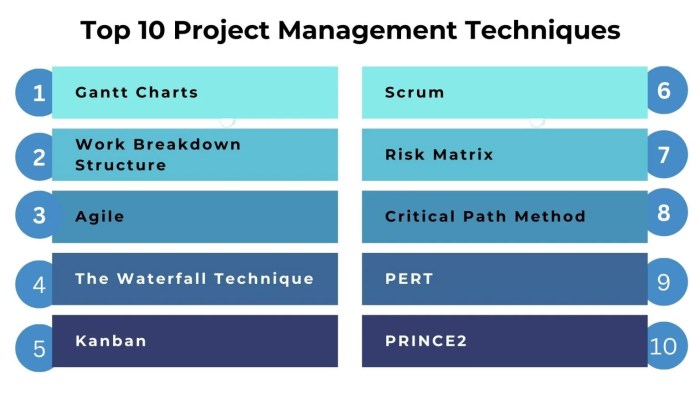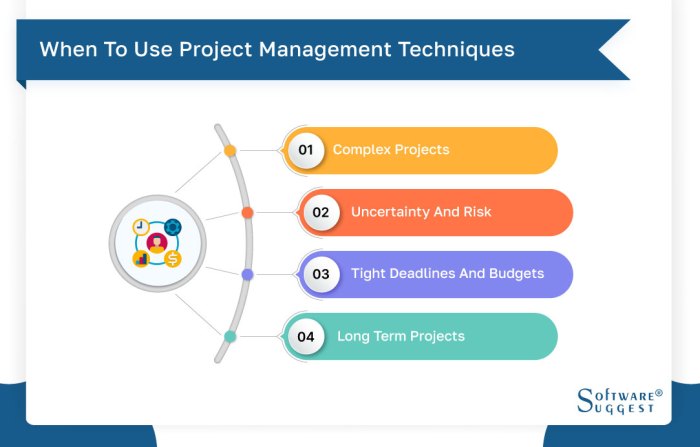Project Management Techniques: Get ready to dive into the dynamic world of project management where strategies and methods shape the path to success in various industries. From traditional methodologies to agile approaches, this journey will uncover the key to effective project management.
Overview of Project Management Techniques
Project management techniques refer to the specific strategies and methods used to plan, execute, and monitor projects effectively. These techniques help ensure that projects are completed on time, within budget, and meet the desired objectives.Utilizing project management techniques is crucial in various industries to streamline processes, improve efficiency, and increase overall project success rates. By implementing these techniques, organizations can better manage resources, minimize risks, and enhance communication among team members.
Popular Project Management Techniques
- Agile Methodology: A flexible approach that focuses on iterative development, allowing for adjustments throughout the project lifecycle.
- Waterfall Method: A sequential approach where each phase of the project must be completed before moving on to the next, ensuring a structured timeline.
- Scrum Framework: A framework that emphasizes collaboration, accountability, and iterative progress through short, fixed-length sprints.
- Kanban Method: A visual system that helps manage workflow by visualizing tasks on a board and limiting work in progress to improve efficiency.
Traditional Project Management Methods

Traditional project management methods, such as Waterfall, have been widely used in various industries for decades. These methods follow a sequential approach where each phase of the project is completed before moving on to the next.
Comparison of Traditional vs Modern Approaches
- Traditional methods are more rigid and sequential, while modern approaches like Agile are more flexible and iterative.
- Traditional methods require detailed planning upfront, whereas modern approaches allow for changes and adaptations throughout the project.
- Traditional methods may be more suitable for projects with clearly defined requirements, while modern approaches are better for projects with evolving or uncertain requirements.
Examples of Successful Projects Managed Using Traditional Methods
- The construction of the Empire State Building in New York City in the 1930s is a classic example of a successful project managed using traditional methods. The project followed a sequential approach, starting with design, then construction, and finally finishing with interior work.
- The development of the Boeing 747 aircraft in the late 1960s is another example of a project that achieved success using traditional project management methods. The project followed a strict schedule and budget, with each phase completed before moving on to the next.
Agile Project Management Techniques
Agile project management is a flexible and iterative approach to managing projects that focuses on delivering value to customers in a fast-paced environment. The key principles of Agile include collaboration, adaptability, transparency, and continuous improvement.
Benefits of Agile Methodologies in Project Management
- Increased flexibility: Agile allows teams to respond quickly to changes and uncertainties in the project, leading to better outcomes.
- Enhanced communication: Regular meetings and open communication channels in Agile ensure that everyone is on the same page and working towards the same goals.
- Higher customer satisfaction: Agile focuses on delivering working products in short iterations, which means that customers can provide feedback early and often.
- Improved quality: Agile emphasizes testing and quality assurance throughout the project, resulting in higher-quality deliverables.
Real-World Examples of Companies Implementing Agile Project Management Successfully
- Spotify: Spotify has adopted Agile practices to continuously improve its music streaming service, allowing for rapid updates and new feature releases based on user feedback.
- Amazon: Amazon uses Agile methodologies to innovate and deliver new products and services quickly, keeping up with the fast-paced e-commerce industry.
- Google: Google implements Agile project management to develop and improve its various software products, ensuring that they meet customer needs and stay competitive in the market.
Risk Management Strategies in Project Management

Risk management is a crucial aspect of project management as it helps in identifying potential issues that may arise during the project lifecycle and developing strategies to mitigate or eliminate these risks. By effectively managing risks, project managers can ensure successful project delivery within scope, time, and budget.
Importance of Risk Management
Risk management allows project teams to anticipate potential obstacles and develop contingency plans to address them proactively. It helps in minimizing negative impacts on project objectives and ensures smooth project execution.
Strategies for Identifying and Mitigating Risks
- Conducting risk assessments: Regularly assess potential risks that may affect the project and prioritize them based on their impact and likelihood of occurrence.
- Creating a risk register: Maintain a comprehensive list of identified risks, their potential impact, and proposed mitigation strategies to track and manage risks effectively.
- Brainstorming sessions: Engage project team members and stakeholders in brainstorming sessions to identify risks from different perspectives and develop innovative solutions to address them.
- Scenario planning: Develop various scenarios based on potential risks and create response strategies for each scenario to ensure preparedness for any unforeseen events.
- Continuous monitoring: Regularly monitor identified risks throughout the project lifecycle and adjust mitigation strategies as needed to address new risks that may arise.
Impact of Effective Risk Management Strategies
Effective risk management strategies have a positive impact on project outcomes by reducing the likelihood of project delays, cost overruns, and quality issues. By proactively addressing risks, project teams can enhance stakeholder confidence, improve project performance, and achieve successful project delivery.
Stakeholder Management Techniques
Stakeholders play a crucial role in project management as they are individuals or groups who have an interest in the project or are impacted by its outcome. It is essential to engage and manage stakeholders effectively to ensure project success.
Role of Stakeholders in Project Management
- Stakeholders provide input, resources, and support for the project.
- They can influence project decisions and outcomes.
- Stakeholders can also help identify risks and opportunities for improvement.
Strategies for Managing Stakeholders Effectively
- Identify key stakeholders early in the project and understand their interests and expectations.
- Communicate regularly with stakeholders to keep them informed and engaged throughout the project lifecycle.
- Address stakeholder concerns and conflicts promptly to maintain positive relationships.
- Involve stakeholders in decision-making processes to ensure their buy-in and support.
Examples of How Stakeholder Management Influences Project Success, Project Management Techniques
- By involving stakeholders in project planning, you can ensure alignment with organizational goals and objectives, leading to a higher likelihood of project success.
- Effective stakeholder management can help prevent scope creep by managing stakeholder expectations and requirements from the outset.
- Engaging stakeholders throughout the project can result in increased support and advocacy for the project, making it easier to overcome obstacles and challenges.
